As a gardener, I know the importance of companion planting to help my crops thrive. When it comes to tomatillos, choosing the right Companion Plants for Tomatillos can make all the difference in the health and yield of the plants. Companion planting involves growing different plants together that benefit each other in some way, such as repelling pests or improving soil quality.

There are many benefits to companion planting with tomatillos. First and foremost, it can help to deter pests and diseases that commonly affect this plant. Additionally, it can improve the soil quality and increase the yield of your tomatillo plants. However, it’s important to choose the right companion plants to ensure they work well together and don’t compete for resources.
Key Takeaways
- Companion planting is an effective way to improve the health and yield of tomatillo plants.
- Choosing the right companion plants can help to deter pests and diseases, and improve soil quality.
- It’s important to select companion plants that work well with tomatillos and don’t compete for resources.
Benefits of Companion Planting
As a gardener, I have found that companion planting is an effective way to improve the health and productivity of my plants. Companion planting is the practice of growing different plant species together in the same space to take advantage of the benefits they offer each other. When it comes to tomatillos, there are several companion plants that can help improve their growth and yield.
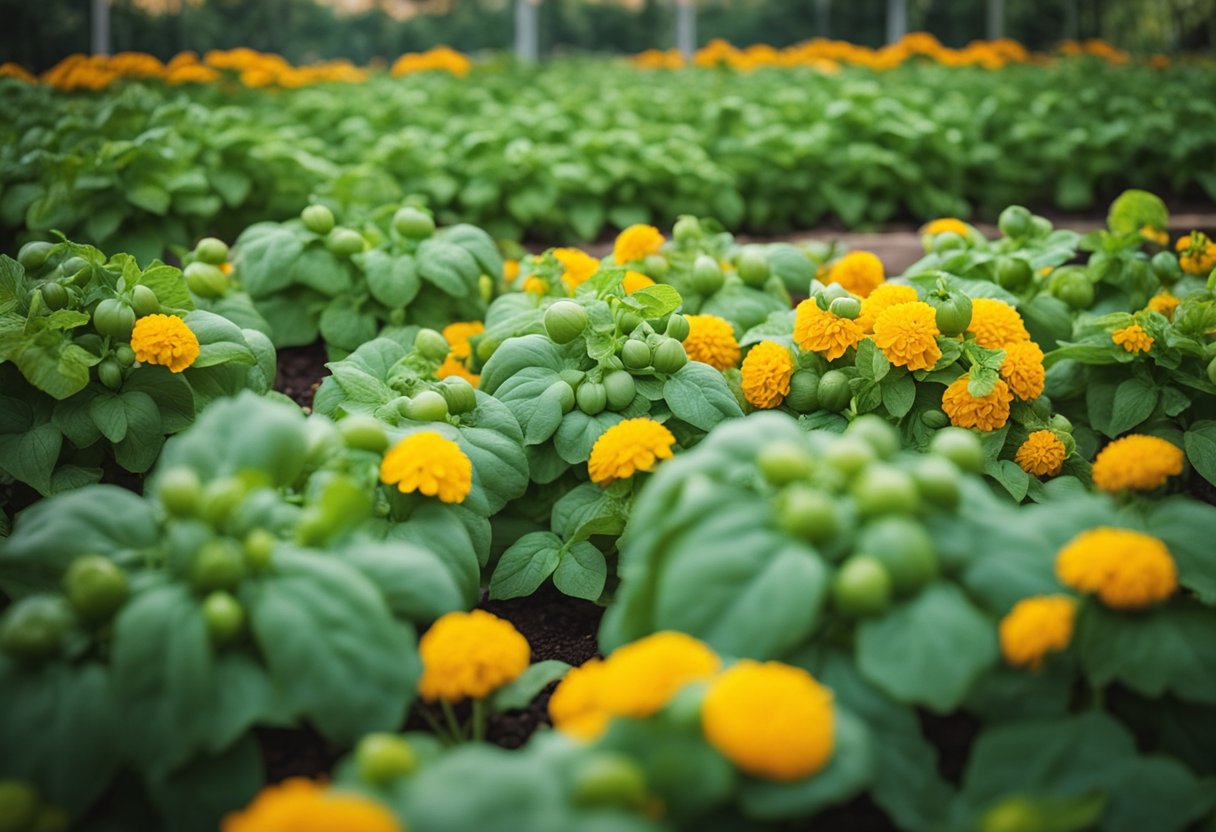
One of the main benefits of companion planting is pest control. Some plants have natural properties that repel or deter pests, while others attract beneficial insects that can help control pests. For example, planting marigolds or nasturtiums near tomatillos can help repel pests like aphids and whiteflies, while attracting beneficial insects like ladybugs and lacewings.
Another benefit of companion planting is improved soil health. Different plant species have different nutrient requirements, and planting them together can help balance the soil’s nutrient levels. For example, legumes like peas and beans can fix nitrogen in the soil, which can benefit tomatillos and other plants that require nitrogen for healthy growth.
Companion planting can also help maximize garden space by allowing plants to share resources like light, water, and nutrients. For example, planting tomatillos with vining beans or peas can help them share a trellis, while also attracting pollinators to the garden.
Companion planting is a simple and effective way to improve the health and productivity of tomatillos and other plants in the garden. By taking advantage of the benefits that different plant species offer each other, gardeners can create a more diverse and resilient garden ecosystem.
Best Companion Plants for Tomatillos
As a gardener, I have found that planting companion plants alongside tomatillos can help reduce their susceptibility to certain pests and diseases while simultaneously maximizing garden space, biodiversity, and soil nutrient availability. In this section, I will share some of the best companion plants for tomatillos.
Basil
Basil is an excellent companion plant for tomatillos. It repels pests such as aphids, whiteflies, and tomato hornworms. Additionally, it improves the flavor of tomatillos when planted nearby. Plant basil in the same bed as tomatillos or in a nearby container for optimal results.
Marigold
Marigolds are another great companion plant for tomatillos. They repel pests such as aphids, whiteflies, and nematodes while attracting beneficial insects such as ladybugs and lacewings. Plant marigolds around the perimeter of the tomatillo bed or interspersed throughout the bed.
Peppers
Peppers are a natural companion plant for tomatillos. They both belong to the nightshade family and have similar growing requirements. Plant peppers alongside tomatillos to create a complementary growing environment. Additionally, peppers repel pests such as aphids and flea beetles.
Onions
Onions are a beneficial companion plant for tomatillos. They repel pests such as aphids and onion maggots while improving the flavor of tomatillos when planted nearby. Plant onions in the same bed as tomatillos or in a nearby container.
Garlic
Garlic is another excellent companion plant for tomatillos. It repels pests such as aphids, whiteflies, and spider mites while improving the flavor of tomatillos when planted nearby. Plant garlic in the same bed as tomatillos or in a nearby container.
Carrots
Carrots are a beneficial companion plant for tomatillos. They repel pests such as carrot rust flies and improve soil health by breaking up compacted soil. Plant carrots in the same bed as tomatillos or in a nearby container.
By planting these companion plants alongside tomatillos, gardeners can create a thriving and healthy garden.
Companion Planting Strategies

When it comes to companion planting for tomatillos, there are several strategies that can be used to maximize the benefits of growing these plants alongside other species. Here are a few key strategies to consider:
1. Pest Control
One of the main benefits of companion planting for tomatillos is pest control. By growing plants that naturally repel or deter pests, you can help protect your tomatillo plants from damage and disease.
Some good companion plants for tomatillos include:
- Basil: repels hornworms and other pests
- Marigolds: repel nematodes and other soil-borne pests
- Garlic: repels aphids, spider mites, and other pests
2. Soil Health
Another important aspect of companion planting for tomatillos is soil health. By growing plants that help improve soil quality and nutrient availability, you can help ensure that your tomatillo plants have the resources they need to thrive.
Some good companion plants for tomatillos that can help improve soil health include:
- Beans: fix nitrogen in the soil, which can benefit tomatillos and other plants
- Clover: also fixes nitrogen and can help suppress weeds
- Comfrey: accumulates nutrients in its leaves, which can be used as a natural fertilizer for tomatillos and other plants
3. Space Optimization
Finally, companion planting can also be used to help optimize space in your garden. By growing plants that complement each other in terms of size and growth habits, you can maximize the use of your garden space and create a more diverse and productive ecosystem.
Some good companion plants for tomatillos that can help optimize space include:
- Cilantro: grows well alongside tomatillos and can be harvested for fresh herbs
- Lettuce: can be grown as a ground cover to help conserve moisture and suppress weeds
- Radishes: can be grown as a quick-maturing crop alongside tomatillos and harvested before the tomatillos reach full size
By using these companion planting strategies and experimenting with different plant combinations, you can help ensure that your tomatillo plants thrive and produce a bountiful harvest.
Plants to Avoid Near Tomatillos
When it comes to companion planting, it’s not just about what plants to grow alongside your tomatillos; it’s also important to know which plants to avoid. Some plants can have negative effects on the growth and health of tomatillos. Here are a few plants to avoid planting near your tomatillos:
Potatoes
Potatoes are members of the nightshade family, just like tomatillos. However, planting them together can lead to the spread of diseases such as late blight, which can devastate both crops. It’s best to keep tomatillos and potatoes separated by at least 30 feet.
Fennel
Fennel is known to release chemicals that can inhibit the growth of nearby plants, including tomatillos. This can lead to stunted growth and reduced yields. It’s best to avoid planting fennel near your tomatillos.
Walnut Trees
Walnut trees release a chemical called juglone, which can be toxic to many plants, including tomatillos. This chemical can remain in the soil for several years, so it’s best to avoid planting tomatillos near walnut trees or in soil that has previously been used to grow walnut trees.
By avoiding these plants, you can help ensure that your tomatillos grow strong and healthy, and produce a bountiful harvest.
Soil and Sunlight Considerations
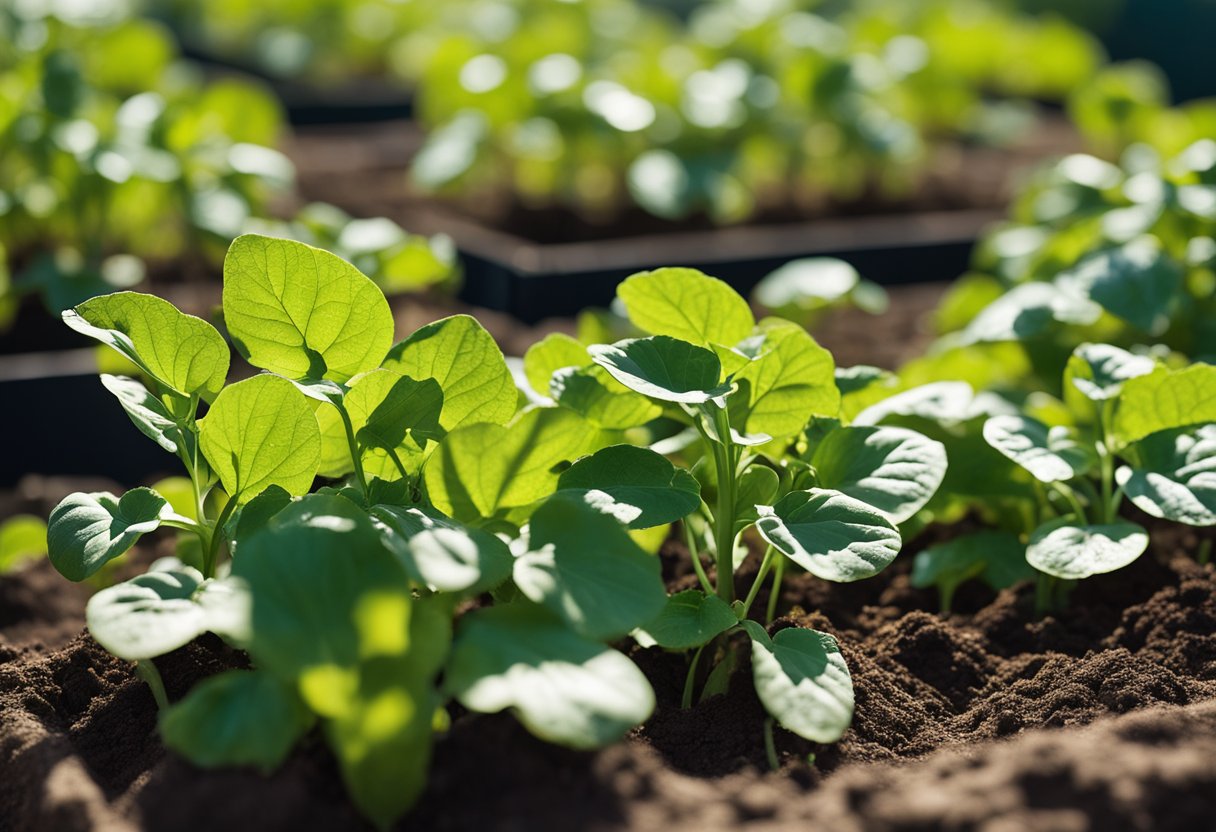
When it comes to growing tomatillos, soil and sunlight are two critical factors to consider. Tomatillos thrive in well-draining soil that is rich in organic matter. Therefore, it is essential to prepare the soil before planting to ensure that it is healthy and nutrient-dense.
I recommend adding compost or well-rotted manure to the soil to improve its texture and fertility. Additionally, tomatillos prefer slightly acidic soil with a pH between 6.0 and 7.0. You can use a soil test kit to determine the pH level of your soil and adjust it accordingly.
Regarding sunlight, tomatillos require full sun to grow and produce fruit. They need at least six to eight hours of direct sunlight every day. Therefore, it is essential to choose a planting location that receives ample sunlight throughout the day.
If you live in an area with hot summers, you may want to consider planting your tomatillos in partial shade to protect them from the scorching sun. However, keep in mind that tomatillos grown in partial shade may produce fewer fruits than those grown in full sun.
Tomatillos require well-draining soil that is rich in organic matter and slightly acidic. They also need full sun to grow and produce fruit. By providing the right soil and sunlight conditions, you can ensure that your tomatillos thrive and produce a bountiful harvest.
Watering and Fertilization Tips
When it comes to growing tomatillos, proper watering and fertilization are crucial to ensure a bountiful harvest. Tomatillos require regular watering, especially during the hot and dry summer months. I recommend watering tomatillos deeply once or twice a week, depending on the weather conditions and soil type. Be sure to water the plants at the base and avoid getting the leaves wet, as this can promote the growth of fungal diseases.
In terms of fertilization, tomatillos benefit from a balanced fertilizer that contains equal parts of nitrogen, phosphorus, and potassium. I recommend applying a slow-release fertilizer at the beginning of the growing season and then supplementing with a liquid fertilizer every two weeks during the growing season. Be sure to follow the manufacturer’s instructions for application rates and timing.
In addition to traditional fertilizers, tomatillos also benefit from organic matter such as compost and manure. These materials can be applied as a top dressing around the base of the plants or worked into the soil before planting. Organic matter helps to improve soil structure, increase nutrient availability, and promote beneficial soil microbes.
It is important to monitor your tomatillos for signs of over or under watering and nutrient deficiencies. Over watering can lead to root rot and fungal diseases, while under watering can cause stunted growth and poor fruit development. Nutrient deficiencies can manifest as yellowing leaves, stunted growth, and poor fruit development. If you notice any of these signs, adjust your watering and fertilization practices accordingly.
Pest Management with Companions
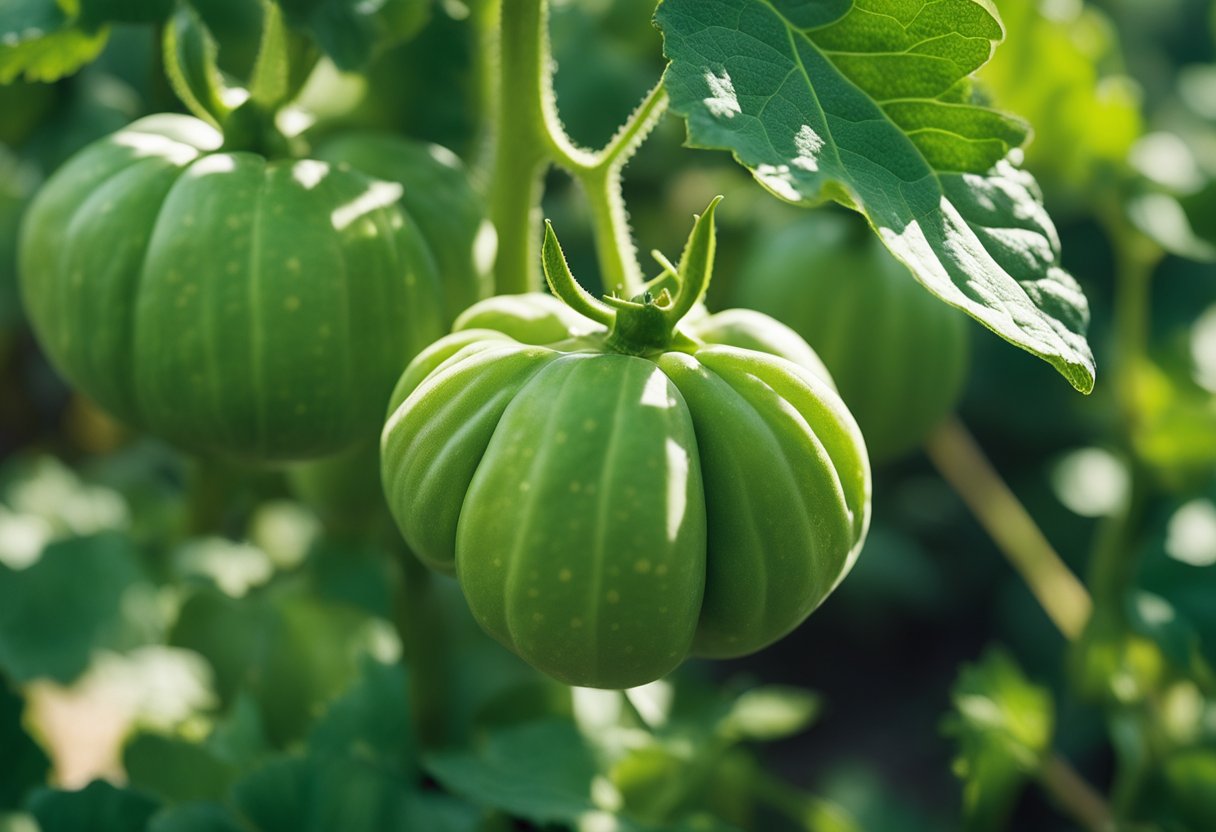
As a gardener, I know how frustrating it can be to deal with pests that damage your plants. Luckily, there are several companion plants that can help you manage pests and protect your tomatillo plants.
One of the most common pests that can damage tomatillo plants is the cucumber beetle. These beetles are attracted to the scent of tomatillo plants, and can quickly devour the leaves and fruits. However, planting certain companion plants can help repel cucumber beetles and keep them away from your tomatillos.
Marigolds are one of the best companion plants for tomatillos, as they release a scent that repels cucumber beetles. Additionally, marigolds attract beneficial insects like ladybugs and lacewings, which can help control other pests like aphids and spider mites.
Another effective companion plant for tomatillos is tansy. Tansy releases a strong scent that repels a wide variety of pests, including cucumber beetles, Japanese beetles, and ants. However, it’s important to note that tansy can be toxic to some animals, so it’s best to avoid planting it if you have pets or livestock.
In addition to repelling pests, some companion plants can also attract predatory insects that feed on pests. For example, planting dill or fennel near your tomatillos can attract parasitic wasps, which lay their eggs inside the bodies of pests like caterpillars and aphids. When the eggs hatch, the wasp larvae consume the pest from the inside out, effectively controlling their population.
Planting companion plants alongside your tomatillo plants can be an effective way to manage pests and protect your harvest. By choosing the right companions, you can create a diverse and resilient garden ecosystem that supports the health and productivity of all your plants.
Pollination Helpers for Tomatillos

As a gardener, I know that pollination is essential for the growth and development of tomatillos. While tomatillos are self-fertile, meaning they can pollinate themselves, having pollinator-friendly plants nearby can increase the yield and quality of your tomatillo harvest.
Here are some companion plants that can help with tomatillo pollination:
1. Bees and Other Pollinators
Bees are one of the most efficient pollinators for tomatillos. They transfer pollen from the male flowers to the female flowers, which results in fruit development. Other pollinators such as butterflies, moths, and hummingbirds can also help with tomatillo pollination. To attract these pollinators to your garden, consider planting flowers such as marigolds, zinnias, and sunflowers.
2. Herbs
Certain herbs can also attract pollinators to your garden. For example, planting borage can attract bees and other pollinators. Borage is a beautiful herb with blue flowers that can also be used in cooking. Other herbs that can attract pollinators include lavender, thyme, and oregano.
3. Companion Plants
Some companion plants such as peppers and eggplants can also attract pollinators to your garden. These plants are in the same family as tomatillos, and they share similar pollination requirements. Planting these plants near your tomatillos can increase the chances of successful pollination.
Having pollinator-friendly plants nearby can help with tomatillo pollination and increase the yield and quality of your harvest. Consider planting flowers, herbs, and companion plants to attract pollinators to your garden.
Spacing and Layout for Companion Planting
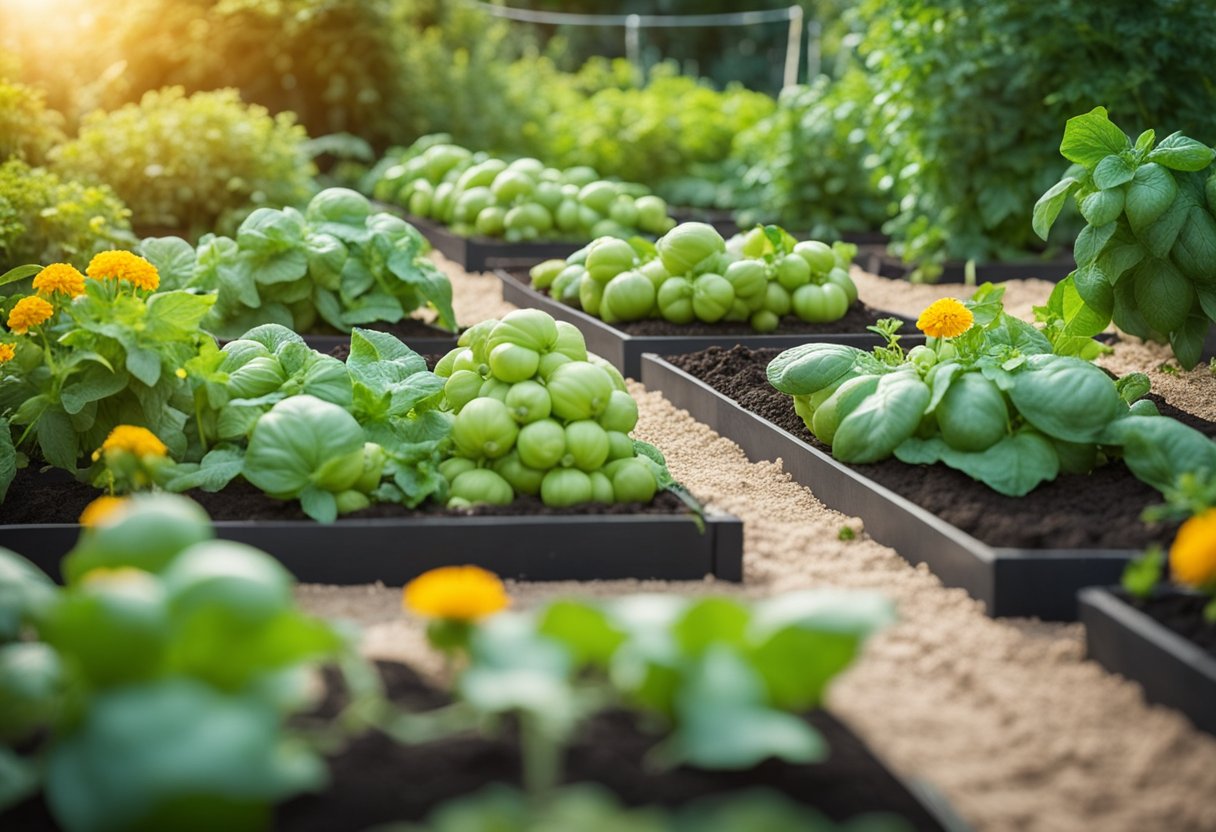
When it comes to companion planting for tomatillos, it is important to consider the spacing and layout of your garden. Proper spacing and layout can help improve the performance and resilience of your tomatillos while also maximizing your garden space and soil nutrient availability.
First, it is important to note that tomatillos are typically planted in rows with a distance of 2-3 feet between each plant. This spacing allows for adequate air circulation and sunlight exposure, which can help reduce the risk of disease and improve overall plant health.
When selecting companion plants for tomatillos, it is important to choose plants that have similar spacing requirements. This can help ensure that each plant has enough room to grow and thrive without competing for resources.
In addition to spacing, it is also important to consider the layout of your garden. Companion plants can be arranged in a variety of ways, including intercropping, row cropping, and block planting.
Intercropping involves planting different types of plants in the same row or bed. This can help improve soil nutrient availability and reduce the risk of pests and diseases. For example, cilantro and marigolds can be planted alongside tomatillos to help repel pests and attract beneficial insects.
Row cropping involves planting different types of plants in separate rows. This can help improve air circulation and sunlight exposure, which can reduce the risk of disease and improve overall plant health. For example, tomatoes and peppers can be planted in separate rows alongside tomatillos to help maximize garden space and improve overall yield.
Block planting involves planting different types of plants in a block or square pattern. This can help improve soil nutrient availability and reduce the risk of pests and diseases. For example, beans and corn can be planted in a block alongside tomatillos to help improve soil fertility and reduce the risk of pests and diseases.
Proper spacing and layout are essential for successful companion planting with tomatillos. By selecting companion plants with similar spacing requirements and arranging them in a way that maximizes garden space and soil nutrient availability, you can help improve the performance and resilience of your tomatillos while also maximizing your overall garden yield.
Harvesting and Storage Tips
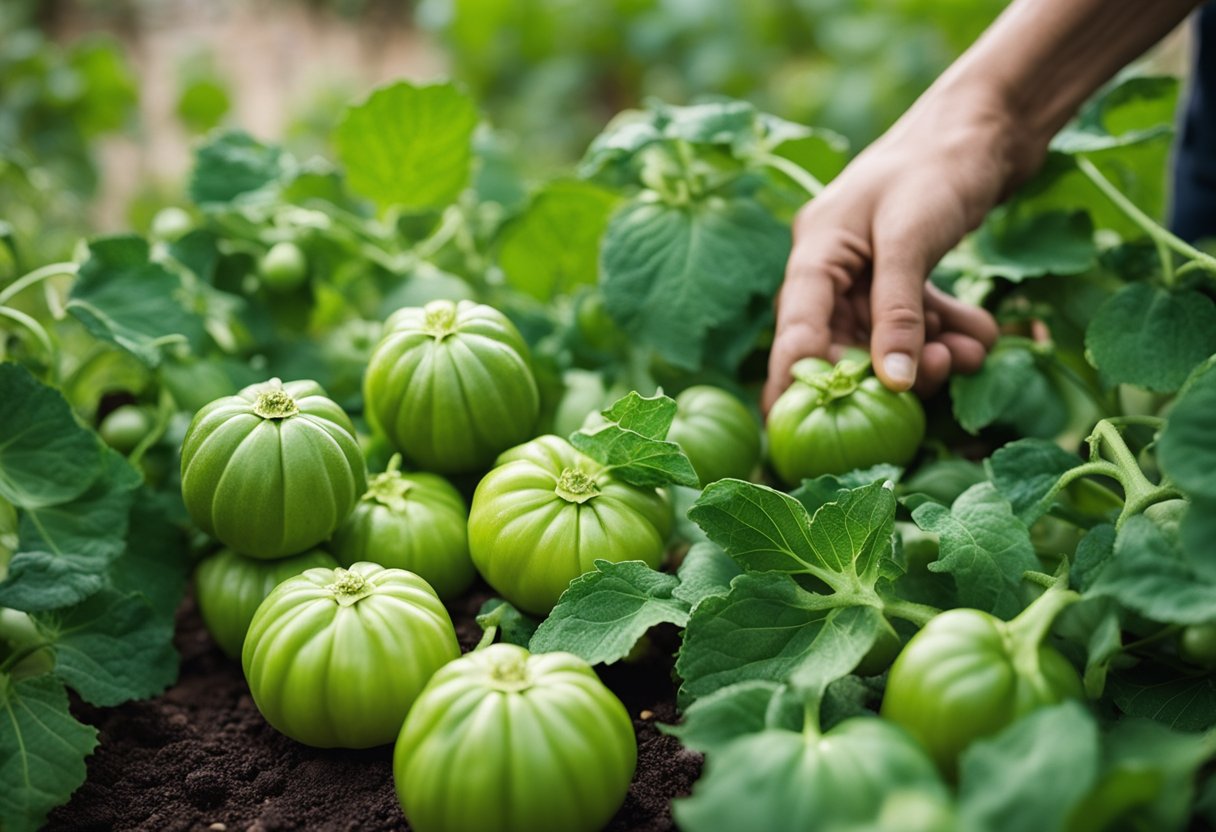
When it comes to harvesting tomatillos, timing is everything. I prefer to wait until the tomatillos are fully ripe before picking them. A ripe tomatillo will have a papery husk that has split open, revealing the fruit inside. The fruit should be firm and a bright green color. If the fruit has turned yellow, it is overripe and may be too sweet for some recipes.
To harvest tomatillos, simply grasp the fruit and twist it gently until it comes off the plant. You can also use a pair of scissors to cut the fruit off the plant. Be sure to leave the papery husk intact until you are ready to use the fruit.
Tomatillos can be stored for several weeks if they are kept in a cool, dry place. I recommend storing them in a paper bag or a cardboard box. Do not store them in plastic, as this can cause them to rot. If you have a large harvest of tomatillos, you can also freeze them for later use.
To freeze tomatillos, remove the papery husks and wash the fruit thoroughly. Cut the tomatillos into quarters or halves and place them on a baking sheet. Freeze the tomatillos until they are solid, then transfer them to a freezer-safe container or bag. Frozen tomatillos can be used in recipes such as salsa or soup.
With these tips, you can enjoy a bountiful harvest of tomatillos and keep them fresh for weeks to come.
Frequently Asked Questions
What are the best companion plants for tomatillos to improve growth?
Tomatillos grow well with plants that have similar sun and water requirements. Some of the best companion plants for tomatillos include basil, cilantro, carrots, garlic, marigolds, and yarrow. These plants can help to repel pests, attract beneficial insects, and improve soil quality.
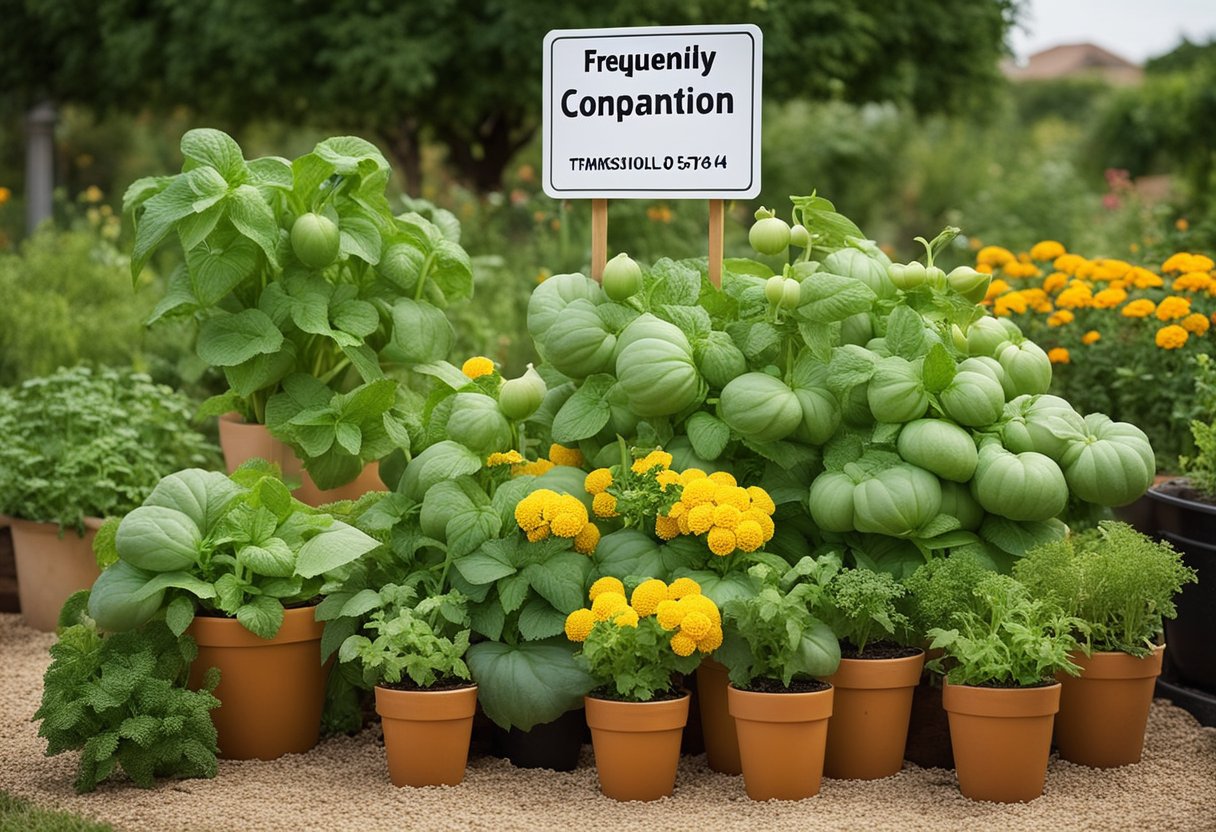
Can tomatillos be planted alongside herbs such as oregano without issues?
Yes, tomatillos can be planted alongside herbs such as oregano without any issues. In fact, oregano can help to repel pests and attract beneficial insects to the garden. However, it is important to make sure that the herbs do not compete with the tomatillos for nutrients and water.
Is it beneficial to grow tomatillos and cucumbers in close proximity?
Tomatillos and cucumbers can be grown in close proximity, but it is important to make sure that they do not compete for nutrients and water. Cucumbers are heavy feeders and require a lot of water, so it is best to plant them in a separate area of the garden.
Are there any advantages to planting tomatillos with nightshade family members?
Tomatillos are a member of the nightshade family, so they can be planted alongside other nightshade family members such as peppers, eggplants, and tomatoes. These plants have similar sun and water requirements and can help to repel pests and attract beneficial insects to the garden.
What spacing is recommended for planting tomatillos in a square foot garden?
Tomatillos should be spaced about 24 inches apart in a square foot garden. This will give them enough room to grow and produce fruit without competing for nutrients and water.
How many tomatillos can typically be harvested from a single plant?
A single tomatillo plant can produce up to 200 fruits in a growing season. However, the number of fruits that a plant produces can vary depending on the growing conditions and the variety of tomatillo.